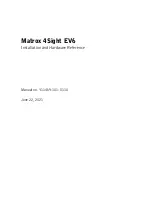
Lucent Technologies Lineage
®
2000 25A Ferroresonant Rectifier J85502A-1
6 - 18 Testing
Issue 4 May 1998
6. If the rectifier drain indication is between 0 and 2% higher
than the amperes calculated in Step 4, this procedure is
completed.
7. If the rectifier drain indication is between 0 and 2% lower
than the amperes calculated in Step 4, adjust potentiometer
R35 on CM2 control board to obtain a rectifier drain
reading that is between 0 and 2% higher than the amperes
calculated in Step 4.
8. If the rectifier drain indication was not within the limits
specified in Step 5 or 6, the isolated current measuring
circuit needs adjustment. See “Adjust Isolated Current
Measuring Circuit (VI)” in Section 7.
Backup High
Voltage
Shutdown
(HVSD) Test (On
Line)
1. If the DC OUTPUT circuit breaker is On, turn it Off
(down).
2. Disable the internal selective HVSD by moving the “Q”
(P15) or “T” (P16) movable straps on CM1 to the Charge
position (see Figure 6-2). Verify that moveable strap P14
remains in the 2-3 (NOT the Charge) position for this test
and after the rectifier is placed into service. The P14
Charge position is only used to raise the Backup HVSD
level of the rectifier when it is being used for applying the
initial charge to connected batteries.
To increase the upper range of the voltage adjustment,
short resistor R22 (24-volt version) or R21 (48-volt
version) on the CM1 board.
3. Set the DMM to measure 27 or 54 volts, and connect it to
test points E2 and E8 on CM1 (see Figure 6-2).
4. Slowly turn the OUTPUT VOLTS ADJ potentiometer
clockwise until the rectifier shuts down. This should occur
between 32.25 and 33.50 volts (24-volt rectifier) or
between 63 and 66 volts (48-volt rectifier). The RFA LED
on the rectifier should light.
When this step is completed, restore R21 or R22. If the
rectifier has List WB (external high voltage shutdown
option), leave straps “Q” and “T” on CM1, in the charge
position, pins 1 and 2. If the rectifier is not equipped with
















































